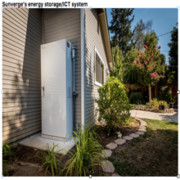 |
| Reviews and Templates for Expression We |
Despite its High Cost, Energy Storage Sees Light in Domestic and Global Markets
Global energy consumption is on the rise. But the price of modern technologies is falling, and that includes not just those to generate cleaner fuels but also those to harness the electrons of those sustainable sources. What does all this mean to environmental managers?
While solar generation is becoming more widespread, the roll out of energy storage that would serve to prevent brownouts is further out. But with all the investment being made in the storage technology, in combination with the mandates to get it done, those tools might get here within a decade.
“The future of energy depends on the deployment of technologies that support intelligent management of distributed resources, and provides the ability to aggregate those resources into virtual power plants (individual storage systems) in Japan and across our worldwide network,” said Tomonori Suzuki, a general manager for Mitsui & Co., LTD, which is a Japanese industrial conglomerate.
It has entered into a relationship with Sunverge Energy to collaborate on developing solar plus storage initiatives in Japan — one that has Mitsui investing $10 million into Sunverge, which makes energy storage devices. What makes this relationship a harbinger of things to come is that Japan is the second largest largest market for solar photovoltaic growth, Sunverge said in an email exchange.
Despite the relative high cost of energy storage now, DNV GL says that there has been more megawatts stored in the last year – worldwide – than over the last 30 years. California’s mandate to install 1,325 megawatts of energy storage by 2020 will be a catalyst, it adds — a mandate that could entail cutting energy use to storing and injecting electrons onto the grid to prevent the lights from flickering off when the voltage changes. Then there’s the 200 megawatts that are now online in Hawaii, all of which is pushing the technology forward.
And a US partnership with Japan makes sense: Japan added 6,900 megawatts in 2013 and 9,600 megawatts in 2014, says the International Energy Agency. Total investment there? Nearly $32 billion last year, notes Bloomberg New Energy Finance, which is up from $28 billion a year earlier.
Meantime, global industry research firm IHS estimates the residential energy storage market in Japan will grow 21 percent annually from 79.9 megawatts in 2016 to 203.2 megawatts in 2020.
In the United States, the solar industry installed 7,286 megawatts of new rooftop solar generation, which is a record, according to joint research by the Solar Energy Industries Association and GTM Research released last week. Altogether the solar photovoltaic rooftop market has grown from 2,000 megawatts in 2010 to 25,000 megawatts in 2015.
What segment of the market is ripe for solar plus storage? “Utilities are proactively looking to storage technology and analytics to enable them to manage their grids more safely, reliably, and cost-effectively in the face of ever-increasing penetration of renewables,” says Ken Munson, chief executive of California-based Sunverge.
As for the utilities, some are moving more aggressively than others. They have made money the old-fashioned way by generating electrons and sending them over the wires. But advances in technologies are causing all of them to consider new business strategies.
Consider: WGL Holdings and Southern Co. are now testing a battery storage system at a 1-megawatt solar array in Georgia. If it works, the device will harness solar electrons and integrate that power onto the grid when the sun is not shining.
As for that deal, Southern’s subsidiary Georgia Power will purchase the output from WGL’s unit Washington Gas, which will consist of 3,388 solar panels that will provide 1.5 million kilowatt hours. The Electric Power Research Institute is helping to test the lithium-ion battery system. Those systems are able to store and to discharge electricity at any time, although they have a limited duration of around 30 minutes to 1 hour.
“I really believe storage is where photovoltaics was maybe four or five years ago,” says Gautam Chandra, senior vice president of strategy for Washington Gas.
However, consulting firm Accenture’s research shows that the current high cost of solar-plus-battery is the main reason the old-fashioned grid will live on. And 79 percent of the utility executives that the consulting firm interviewed agree, saying that only 12 percent of customers in North America are expected to become energy self-sufficient by 2035.
But it quickly adds that the revenues of traditional utilities in the next 10 years may fall by as much as 15 percent, or $48 billion over that time. That’s a direct result of new competitors moving in and taking business away from what have been monopolies, as well as greater costs tied to integrating variable sources like wind and solar energy onto the grid.
As the electricity market is realigning, the participants are trying to match up so that they don’t get left behind. And that’s the impetus behind the partnerships between Sunverge and Mitsui and Southern Co. and Washington Gas, all of which will give corporate environmental managers more options.
|
|
|
|
Copyright remains with the original authors |
